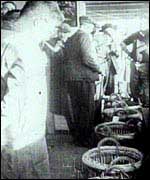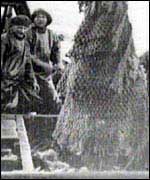|
East Anglian fishing reaches back into the mists of time.
Coastal settlements and communities are evidenced as far back as Stone
Age man.
From those early beginnings a huge industry was spawned,
reaching its economic peak in the first part of the 20th century.
Stone Age man survived on a diet of fish, wild mammals,
birds, wild fruits and nuts. Their whole existence was focussed on food
gathering.
For communities living on the east coast of Britain, the
regular harvest of wild fish made a significant contribution to their
'hunter gathering'.
Hunter Gathererers
Fishing from open boats required strength, knowledge,
wisdom and, above all, courage. Going to sea in a small boat was a risk
to life and limb.
To the hunter gatherers, coastal fishing was a high risk,
high reward food strategy.
As wild food reserves fell, communities adopted settled
farming practices.
This change also happened on the east coast, but the fishing
communities had access to the wide expanses of Northern waters which teemed
with fish.
Farming and fishing communities throughout Britain progressed
to the present day, where the fishermen of Britain's East coast remain,
the last of the hunter gatherers.
This was their downfall because declining North Sea fish
stocks, national protection of the Northern waters (Iceland and Greenland)
and EEC intervention has all but closed down the East coast fishing industry.
Fish and Ships
 |
|
The
Fish market |
Fish and chips are an integral part of British life, allegedly
the national dish, yet few people consider the risks, the human endurance
and the human cost in lives over the years to provide such a nourishing
and universally popular meal.
After the virtual cessation fishing during World War II
fish stocks were plentiful and the UK fishing industry entered a 'golden'
period.
Entry to the Common Market in 1973, caused a reduction
from 12 to 6 miles in the coastal exclusion zone for foreign trawlers.
At the same time Iceland established a 50 mile exclusion
zone to protect it's own stocks and a vicious stand off with Britain
led to the “Cod Wars”.
As a result British trawlers were forced to fish even
closer to home where they were faced with dwindling stocks and increased
competition for them from other EEC members.
There was little or no planning for the future by the
UK government, the EU or fishermen themselves.
Fish stocks were treated as limitless and whilst scientists'
warnings of diminished stocks were largely ignored their improved fishing
techniques were eagerly grasped.
Many stocks have been too heavily exploited or have low
quantities of mature fish or both.
The capacity of the EC fleets exceeds that compatible
with the sustainable harvest of North Sea fish.
 |
| A steady decline in North Sea cod
landings |
The Super trawler
The Ranger Cadmus was a stern factory trawler, sister
ship to the ill-fated Gaul.
The vessel had an overall length of 216ft, breadth 40ft
with a loaded draft 16ft. Gross tonnage was 1106.
The main engine was a 16 cylinder, four stroke, diesel
developing 2600 BHP. Fuel oil tanks had a capacity of 290 tons, fresh
water tanks 38 tons and liver oil tanks 23 tons.
Frozen fillets
The vessel was able to catch, gut, fillet, skin, freeze
and pack all the fish caught in addition to producing fish meal and fish
liver oil.
There was accommodation for a crew of 50 comprising captain,
ship's Officers, factory managers, two cooks and thirty seven seamen.
The catch was discharged from the cod end down a chute
to the factory deck.
While awaiting processing, the fish was kept cool by a
chilled seawater spray system.
 |
|
The net
is emptied |
After sorting, gutting and washing, fish were mechanically
filleted and skinned.
After skinning, the fillets were arranged in 10lb blocks
for freezing.
Each horizontal plate freezer could freeze 750 kg of fillets
in less than two hours and the plant was designed for a throughput of
20 tons in 24 hours.
Total fish hold capacity was 21,000 cu.ft and the fishmeal
hold had a capacity of 7,000 cu.ft.
Hi-tech fishing
The fish finding and navigational aids provided combined to make these
super trawlers very efficient and successful.
To enable the most reliable information to be available
to the skipper, the fish finding aids included;
Elac Superlodar Sonar
Lodarscope LAZ 44
Arcturus/Fishlupe steady picture -bottom lock
fish finder and Elac Netsounder
Sperry Rand Mark 37 Mod C Gyro compass and Auto
Pilot
Decca radar
Marconi Fishgraph-K multi stylus recorder
Redifon communications equipment
Life saving arrangements consisted of a class 'C' lifeboat
and an inflatable boat.
|

